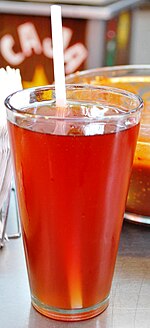Tepache
 | |
| Course | Beverage |
|---|---|
| Place of origin | Mexico |
| Serving temperature | cold |
| Main ingredients | pineapple, piloncillo |
| Variations | added beer and cinnamon |
Tepache is a fermented beverage made from the peel and the rind of pineapples, and is sweetened either with piloncillo or brown sugar. It is sometimes seasoned with chili powder and served cold. Tepache is usually sold as a chilled drink by street vendors in Mexico, stored in barrels to expedite the fermentation process. It is served either in a clay mug or in a clear plastic bag with a straw inserted for easier travel. In the U.S., it is sold in juice bars or traditional Mexican restaurants within Mexican American communities of the Southwestern United States.
The fermentation process for making tepache is simple and quick, making it a drink readily produced at home. Though tepache is fermented for several days, the resulting drink does not contain much alcohol. The fermentation process relies on naturally occurring yeast and bacteria present on the pineapple peels and in the environment. The sugar serves as a nutrient source for these microbes, which produce lactic acid and carbon dioxide, contributing to tepache's slight effervescence and tart flavor.
Tepache is fermented by different microorganisms. Bacteria, such as Lactobacillus pentosus, L. paracasei, L. plantarum, L. lactis and yeast from the genus Saccharomyces have been found in tepache.[1] For optimal fermentation, it is recommended to use unrefined sugar such as piloncillo, which enhances the flavor and color of the drink. Tap water should be filtered to remove chlorine, which can inhibit the fermentation process. In Mexican culinary practice, the alcoholic content of tepache may be increased with a small amount of beer.
Origin
[edit]Tepache dates from Pre-Columbian Mexico, as a popular drink among the Nahua people of central Mexico; in the Nahuatl (also known as Aztec) language, the word tepiātl means 'drink made from corn'. Originally, corn (maize) was the base of tepache, but the contemporary recipe for tepache uses pineapple rinds as the foodstuff fermented to produce the tart drink that is tepache. Some varieties of tepache, known as tepache de tibicos, are fermented using symbiotic cultures of tibicos.[2]
Commercialization
[edit]Because of the popularity of tepache in Mexico, the drink is now being produced commercially as a non-alcoholic drink. There are a few different brands of tepache including Tepache from the Frumex Corporation. The original Frumex Tepache contained 12% juice and was made from fermented skins and pulp along with some sugar, spices, and barley. That version was replaced with a newer version that contained only 10% juice and no barley. That one was made from only fermented pineapple juice, no skins or pulp. The latest version, now rebranded as Tepachito, still contains only 10% juice but it is made from fermented juice and skin, no barley. It does include white and brown sugar and spices.
In popular culture
[edit]The drink tepache is mentioned in the popular Spanish-language quebradita song "La Niña Fresa" ('The Spoiled Girl'), by Banda Zeta, in which the spoiled-girl character is offered several types of drink—including tepache—yet she refuses them all, for being beneath her social status.[3] The drink tepache is also mentioned in Cornelio Reyna's song "Botellitas" about different bottles of alcohol.
See also
[edit]- Indigenous cuisine
- Tejuino
- Pulque
- Chicha de piña
- Kvass, another lightly-fermented drink low in alcohol
- Kombucha, lightly-fermented tea drink
References
[edit]- ^ Ligenza, Alicja; Jakubczyk, Karolina Patrycja; Kochman, Joanna; Janda, Katarzyna (2021-09-27). "Health-promoting potential and microbial composition of fermented drink tepache". Medycyna Ogólna i Nauki o Zdrowiu (in Polish). 27 (3): 272–276. doi:10.26444/monz/138713. ISSN 2083-4543.
- ^ Velázquez‐Quiñones, Sahian Enitze; Moreno‐Jiménez, Martha Rocío; Gallegos‐Infante, José Alberto; González‐Laredo, Rubén Francisco; Álvarez, Saúl Alberto; Rosales‐Villarreal, Mayra Cristina; Cervantes‐Cardoza, Verónica; Rocha‐Guzmán, Nuria Elizabeth (2021). "Apple Tepache fermented with tibicos: Changes in chemical profiles, antioxidant activity and inhibition of digestive enzymes". Journal of Food Processing and Preservation. 45 (7). doi:10.1111/jfpp.15597. S2CID 235567051.
- ^ "La Chica Fresa Lyrics". Archived from the original on 2014-01-04. Retrieved 2014-03-12.

